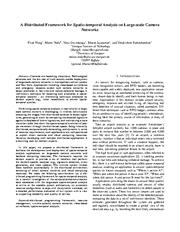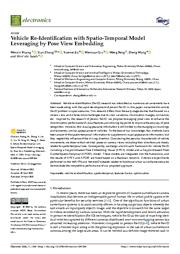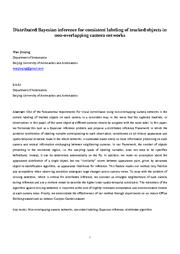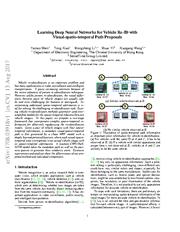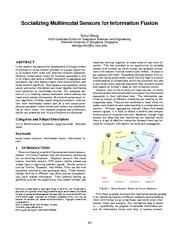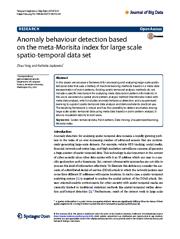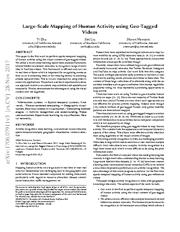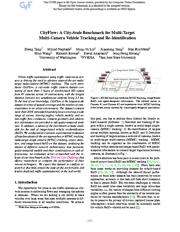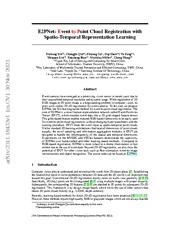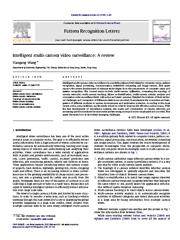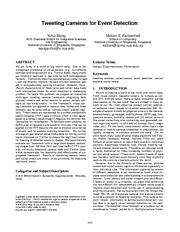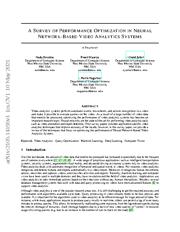A copy of this work was available on the public web and has been preserved in the Wayback Machine. The capture dates from 2017; you can also visit the original URL.
The file type is application/pdf.
Filters
A Distributed Framework for Spatio-Temporal Analysis on Large-Scale Camera Networks
2013
2013 IEEE 33rd International Conference on Distributed Computing Systems Workshops
In this paper, we propose a distributed framework to facilitate the development and deployment of spatio-temporal analysis applications on large-scale camera networks and backend computing resources. ...
Performing spatio-temporal analysis in real-time for a largescale camera network is challenging. ...
enable spatio-temporal analysis for a large-scale camera network. ...
doi:10.1109/icdcsw.2013.44
dblp:conf/icdcsw/HongVGJR13
fatcat:d7dzefcjlvavdfvbet2omucsiq
Toward large-scale situation awareness applications on camera networks
2013
2013 IEEE International Conference on Pervasive Computing and Communications Workshops (PERCOM Workshops)
To solve the problem, my research topic concerns developing a programming model and a runtime system to support large-scale situation awareness applications on camera networks. ...
Ubiquitous deployment of cameras and recent advances in video analytics enable a new class of applications, situation awareness using camera networks. ...
I have developed a distributed framework [3] for providing automatic resource management for the spatio-temporal analysis technique with colleagues from SUNY-Buffalo who have developed algorithms for ...
doi:10.1109/percomw.2013.6529530
dblp:conf/percom/Hong13
fatcat:pbrc2ptnprdgxgh2mwzvs7cdpa
Vehicle Re-Identification with Spatio-Temporal Model Leveraging by Pose View Embedding
2022
Electronics
Consequently, we design a two-branch framework for vehicle Re-ID, including a Keypoint-based Pose Embedding Visual (KPEV) model and a Keypoint-based Pose-Guided Spatio-Temporal (KPGST) model. ...
These models are integrated into the framework, and the results of KPEV and KPGST are fused based on a Bayesian network. ...
Acknowledgments: The authors would like to thank the anonymous reviewers and the editor for their careful reviews and constructive suggestions to help us improve the quality of this paper. ...
doi:10.3390/electronics11091354
fatcat:ewaqghwiivha7h6wdfottsvati
Distributed Bayesian inference for consistent labeling of tracked objects in non-overlapping camera networks
[article]
2013
arXiv
pre-print
, conditioned on all history appearance and spatio-temporal evidence made in the whole networks, is calculated based solely on local information processing on each camera and mutual information exchanging ...
One of the fundamental requirements for visual surveillance using non-overlapping camera networks is the correct labeling of tracked objects on each camera in a consistent way,in the sense that the captured ...
Acknowledgement The authors are grateful to the student volunteers for their participation in the tracking experiments. ...
arXiv:1306.0974v1
fatcat:2mtdaphg3rda3bzwy7vfyfk5lu
Learning Deep Neural Networks for Vehicle Re-ID with Visual-spatio-temporal Path Proposals
[article]
2017
arXiv
pre-print
In this paper, we propose a two-stage framework that incorporates complex spatio-temporal information for effectively regularizing the re-identification results. ...
Given a pair of vehicle images with their spatio-temporal information, a candidate visual-spatio-temporal path is first generated by a chain MRF model with a deeply learned potential function, where each ...
[29] proposed an approach for multi-camera activity correlation analysis which estimates the spatial and temporal topology of the camera network. ...
arXiv:1708.03918v1
fatcat:3rfxnsfcezamzbgnio2z5y74pq
Socializing Multimodal Sensors for Information Fusion
2015
Proceedings of the 23rd ACM international conference on Multimedia - MM '15
Our proposal consists of 1) a tweeting camera framework where cameras can tweet event related information; 2) a hybrid social sensor fusion algorithm utilizing spatio-temporal-semantic information from ...
However, social sensor fusion for situation awareness is still in its infancy and lacks a unified framework to aggregate and composite real-time media streams from diverse sensors and social network platforms ...
We quantitatively evaluated proposed tweeting cameras framework in Figure 2 with this large-scale dataset. ...
doi:10.1145/2733373.2807995
dblp:conf/mm/Wang15
fatcat:7g7rgxylprfijfgi7wwhwilig4
Anomaly behaviour detection based on the meta-Morisita index for large scale spatio-temporal data set
2018
Journal of Big Data
The resulting framework is robust and has the capability to detect anomalies among large-scale spatio-temporal data using meta-data based on point pattern analysis. ...
For example, vehicle GPS tracking, social media, financial network and router logs, and high resolution surveillance cameras all generate a huge amount of spatio-temporal data. ...
Availability of data and materials The data sets supporting the results of this article are included within the article
Consent for publication All authors have approved the manuscript and agree with ...
doi:10.1186/s40537-018-0133-8
fatcat:ojgglsl37zcr3fmoubhgjjxt74
Large-Scale Mapping of Human Activity using Geo-Tagged Videos
[article]
2017
arXiv
pre-print
We utilize a recent deep-learning based video analysis framework, termed hidden two-stream networks, to recognize a range of activities in YouTube videos. ...
This paper is the first work to perform spatio-temporal mapping of human activity using the visual content of geo-tagged videos. ...
This work was funded in part by a National Science Foundation CA-REER grant, #IIS-1150115, and a seed grant from the Center for Information Technology in the Interest of Society (CITRIS). ...
arXiv:1706.07911v3
fatcat:q5ejnmm3wfd3hbwokkbx4p5gzy
CityFlow: A City-Scale Benchmark for Multi-Target Multi-Camera Vehicle Tracking and Re-Identification
2019
2019 IEEE/CVF Conference on Computer Vision and Pattern Recognition (CVPR)
Camera geometry and calibration information are provided to aid spatio-temporal analysis. ...
, analyzing the impact of different network architectures, loss functions, spatio-temporal models and their combinations on task effectiveness. ...
[29] propose a progressive and multimodal vehicle ReID framework (PROVID), in which a spatio-temporal-based re-ranking scheme is employed. ...
doi:10.1109/cvpr.2019.00900
dblp:conf/cvpr/TangN0YBWKAH19
fatcat:w32nnafuajee5hfcopvtlob5ly
E2PNet: Event to Point Cloud Registration with Spatio-Temporal Representation Learning
[article]
2023
arXiv
pre-print
EP2T treats the event input as spatio-temporal point clouds. ...
Event cameras have emerged as a promising vision sensor in recent years due to their unparalleled temporal resolution and dynamic range. ...
VECtor [43] uses a 128-beam LiDAR and an event camera with a resolution of (640,480). Different from MVSEC, VECtor contains various large-scale indoor environments with long trajectories. ...
arXiv:2311.18433v2
fatcat:r7xtvmblgrc6vbtm5cnrrji47m
Spatio-temporal metadata filtering and synchronising in video-surveillance
2016
Ingénierie des Systèmes d'Information
To cite this version : Codreanu, Dana and Oria, Vincent and Péninou, André and Sèdes, Florence Spatio-temporal metadata filtering and synchronising in video surveillance. (2016) Ingénierie des Systèmes ...
d . u p s -t l s e . f r module (based on a generic framework for indexing large scale distributed multimedia contents that we have developed in the LINDO project). ...
Nevertheless, filtering is based on a video analysis relying on a learning process that supposes a big volume of data and that is difficult to implement on a larger scale. ...
doi:10.3166/isi.21.3.75-91
fatcat:ry3bhianwrcs3lmtkpp7y27pbm
Intelligent multi-camera video surveillance: A review
2013
Pattern Recognition Letters
The covered topics include multi-camera calibration, computing the topology of camera networks, multi-camera tracking, object re-identification, multi-camera activity analysis and cooperative video surveillance ...
With the fast development of surveillance systems, the scales and complexities of camera networks are increasing and the monitored environments are becoming more and more complicated and crowded. ...
However, larger scale camera networks are needed for future research. ...
doi:10.1016/j.patrec.2012.07.005
fatcat:vnbxmu55x5ditdmhjvsmloezr4
CONVINCE: Collaborative Cross-Camera Video Analytics at the Edge
[article]
2020
arXiv
pre-print
In dense deployment, video nodes typically demonstrate a significant spatio-temporal correlation. ...
To overcome these obstacles in current approaches, this paper introduces CONVINCE, a new approach to look at the network cameras as a collective entity that enables collaborative video analytics pipeline ...
Distributed approach In this setting, all AI cameras are communicating with each other. Each camera needs to know the topology or the spatio-temporal correlations of the other cameras in the network. ...
arXiv:2002.03797v1
fatcat:vjvf5ou2qjedloior4djiicvt4
Tweeting Cameras for Event Detection
2015
Proceedings of the 24th International Conference on World Wide Web - WWW '15
We quantitatively evaluate our framework with a large-scale dataset containing images from 150 New York real-time traffic CCTV cameras, university foodcourt camera feeds and Twitter data, which demonstrates ...
These tweets are represented by a unified probabilistic spatio-temporal (PST) data structure which is then aggregated to a concept-based image (Cmage) as the common representation for visualization. ...
We thank the Ambient Intelligence Laboratory, NUS for sharing the NUS foodcourts camera data and associated analysis. We also would like to thank our SeSaMe colleague Dr. ...
doi:10.1145/2736277.2741634
dblp:conf/www/WangK15
fatcat:c3i6mehycbcgjpkaiykcvnplau
A Survey of Performance Optimization in Neural Network-Based Video Analytics Systems
[article]
2021
arXiv
pre-print
Neural networks are the state-of-the-art for performing video analytics tasks such as video annotation and object detection. ...
As a result of a large number of video data that need to be processed, optimizing the performance of video analytics systems has become an important research topic. ...
Distream Distream [38] is a framework for distributed live video analytics based on the smart camera-edge cluster architecture. ...
arXiv:2105.14195v1
fatcat:klq3urgjsjhb7ef7qfdp6dly3u
« Previous
Showing results 1 — 15 out of 9,224 results

